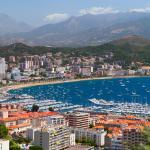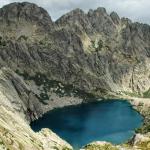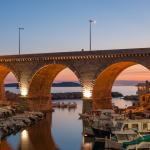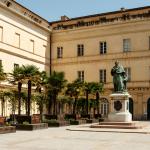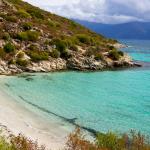As the sun sets over the private beach at Monte Carlo’s Le Meridien Beach Plaza hotel, Garance Doré stands barefoot in the sand, surveying the scene around her. Clad in a white sleeveless top, billowing Elizabeth and James satin pants, and oversized sunglasses, the writer/illustrator/photographer/style influencer—whose work has appeared in publications like the New York Times, Elle, and Vogue, and who commands a devoted following at her lifestyle site—watches as a chic group enjoys a game of beachside boules. A line forms for the free-flowing rosé bar, and a crowd dances to the sounds of French lounge-pop collective, Nouvelle Vague. As the curator of Le Meridien’s Au Soliel: Summer Soiree event series (which takes place through the fall, in locations as far flung as Santa Monica and Bali), the Corsica-born, Paris-bred Doré was tasked to come up with a collection of touchpoints that best evoked an “endless Mediterranean summer,” and these are the elements she envisioned, come to life.
And while she’s been tasked with distilling summer over tea on the hotel’s terrace, Doré revealed to Robb Report that she believes the best way to travel “like a European” along the Mediterranean is actually in the fall. “Europeans typically have more vacation, so when it comes to traveling, they have a different sense of time. It’s about celebrating the ‘art of life’—or really, the art of doing nothing,” she explains. “The best time for that is the autumn, when the crowds have thinned and you can take your time to explore a place and live like a local.”
Here, Doré gives us her insider tips for exploring her favorite destinations along the French Mediterranean—where summer is always in the air, no matter what the calendar says.
- Aerial view of Ajaccio city. Corsica, France.; Shutterstock ID 456651427; Notes: Ajaccio and museum
- The old harbor “Vallon des Auffes” in Marseille in South France after sunset; Shutterstock ID 287072342; Notes: marseille
- AJACCIO, CORSICA, FRANCE, AUGUST 30, 2016: Statue of cardinal Joseph Fesch in the foreground of the museum ; Shutterstock ID 604870730; Notes: Ajaccio and museum
- Wild beach along the seaboard way through Desert of Agriates to plage of Saleccia, Corsica, France; Shutterstock ID 135054605; Notes: saleccia
Corsica
Fall is idyllic in Corsica, when the island is covered in flowers, it’s not too hot, and there are not too many tourists. It’s a great time to get in the rhythm there—to sit at a café, enjoy the flavors of autumn (like chestnuts), and stay too long at the beach, where the late afternoons are the most magical.
Start in capital city Ajaccio, where you can meander through the narrow streets, visiting sites like the town cathedral and Musée Fesch(which has the second largest collection of Italian Old Masters in France, after the Louvre), then stop to eat at one of the quaint restaurants or street markets. Don’t miss the charcuterie and cheeses—Corsica has some of the best of both—or a meal at Le Bilboq (which locals call Chez Jean-Jean), known for the unforgettable lobster pasta. If you’re craving sweets, Galeani bakery makes the most delicious baked goods with flavors from the area, like anise and chestnut. (And if you visit the north-central region of Corte, don’t miss its signature treat, falculelle, a small cake cooked on top of a chestnut leaf.) For shopping in Ajaccio, head to Rue Fesch, best for swimsuits, shoes, and antiques. The island’s smaller villages are also great to explore in the fall (when they are lush and green, in both color and scent), as is the GR20. It’s one of the largest natural reserves in France, with trails that take you along rivers, mountain peaks, and even goat farms.
I’m from the Mediterranean, so nothing can ever replace the sound of the waves in Corsica for me (and the new Hotel Miniscu is one of the best places to stay to soak up the sea). My favorite beaches a day trip away from Ajaccio include Seleccia in the Agriates desert, where you can picnic on the white sand, and Capo di Feno beach, which I love because there is no cell phone reception there at all. After spending the day there (maybe playing a game with some locals), walk down to the very end of the beach to the small Chez Pierre-Tou restaurant. This is where I like to end the day with some delicious grilled fish and a glass of rosé, with the saltwater still in my hair and friends all around. That’s what I call a vacation.
South of France
Provence is a familiar second home to me. I spent so much time there in my twenties that I almost took it for granted, but I now understand there are very few places as inspiring in the world. I would recommend renting a villa in the area and touring around a little bit every day, saving time to just taste the slow life—go to the market, take a nap on a terrace, and drink some good wine.
A great place for the latter is Chateau La Coste, a winery and art foundation about 25-miles north of Aix-en-Provence. The spectacular grounds house vineyards and winery (where you can taste some excellent rosés), as well as several restaurants, and an art center designed by noted Japanese architect Tadao Ando. Stop in this fall to catch exhibits highlighting the works of Irish artist/sculptor Guggi, and the photography of American painter Cy Twombly.
Find more art and culture in Aix-en-Provence. The Hotel Caumont is an elegant palace-style estate where you can enjoy lunch, walks through designer gardens, and art films and exhibits—I’m looking forward to this fall’s look at Chagall’s juxtaposition of black-and-white and color. Nearby, the Gallifet Art Center exhibits contemporary art and live music, while the Musee Granet’s fall exhibitions include a showcase of French mid-century “non-figurative” painters. While wandering around Aix, be sure to look at the floors; the traditional terra cotta tomettes tiles are both beautiful and a great design inspiration.
Good food can be enjoyed throughout the region, but for some unique specialties, I always head to Marseilles. Savor bouillabaisse, the town’s most famous dish, at Le Château restaurant right at the water’s edge in the Calanque Sormiou inlet—it’s a favorite spot with both locals and visitors. It’s also fun to grab a bottle of wine and some grilled sardines on the beach—you can’t go wrong with fresh fish here. But Marseille’s surprising hidden specialty is actually pizza. You can find delicious versions in almost every neighborhood, but a top locals’ pick is Chez Jeannot near the harbor, where can enjoy your meal overlooking the sea.
Source: Rob Report



